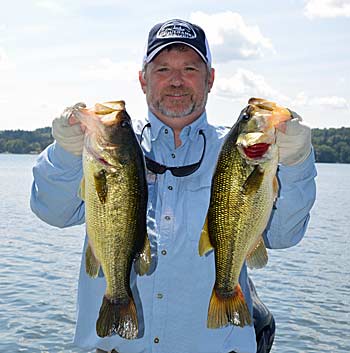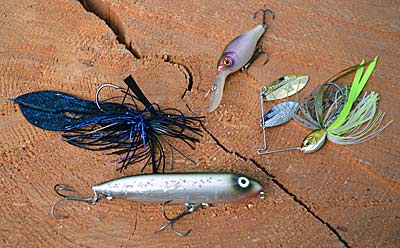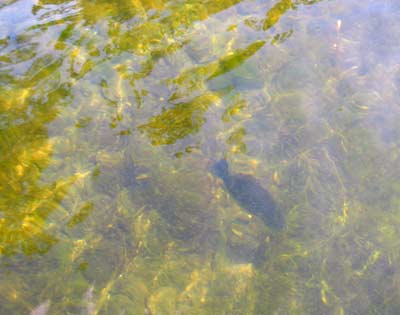
Poll avid bass anglers about their favorite season to hit the water, and fall will be a top choice for many. While springtime fishing for hungry pre-spawners may take a slight edge with some, there are plenty of reasons to fish in autumn. The weather is more comfortable, with cooler temperatures and less humidity. Pleasure boaters are few and far between. Even the fair-weather anglers have hung it up until the dogwoods bloom. And the changes underway seem to make the bass bite, too.
The calendar says fall arrives Sept. 21 and ends Dec. 21. But only Mother Nature decides for real. Summer heat may continue through the first part in some portions of the bass range, and wintery weather may arrive sooner than later in others. However, specific environmental changes during fall cue bass to move, eat, and prepare for the upcoming winter, regardless of where they swim.
One of the most significant cues is the steady reduction in daylight. Anglers and bass notice days getting shorter. And it causes more than later sunrises and earlier sunsets. Here are three ways it directly affects bass:
- Cooler water temperatures: Fewer hours of daylight and weaker rays because of the Earth's tilt mean less opportunity for the sun to warm the water. Cooling water slows the metabolism of all cold-blooded aquatic creatures, including bass. In response, their activity slows as fall progresses.
- Less aquatic vegetation: Like their land-based cousins, aquatic vegetation requires sunlight for photosynthesis. Less daylight slows that process, hampering the growth of some and ending life altogether for others. Many beds are lush and green one week and gone the next.
- Time to move: Less daylight also acts as a signal, playing a part in pushing bass toward spots that are better suited to wintertime survival. It’s similar to what happens in spring when bass move toward shallow water to spawn as daylight steadily increases. In fact, these travels often use many of the same routes and spots.
Understanding the overall picture helps you focus on the small details that can significantly improve your autumn bass fishing. They include what to look for in potential hot spots and lure choices. So, when you're ready to hit the water this fall, apply these four points to your fishing.
Search Out Sharp Edges
Fall air is crisp. The edges of the structure and cover you target should be, too. For example, the best shallow inside and deep outside edges of aquatic vegetation beds may not run straight, but they are easily distinguishable, like a trimmed hedge. And shallow-water ledges and creek channel swing banks should fall almost vertically, even if the depth change is better measured in inches than feet.
A clean edge is especially attractive to big smallmouth in the fall. They gather in small “wolf packs,” either by rogue fish joining together or large deep-water schools dividing. Patrolling relatively shallow water, they cruise along, herding baitfish against the edge, which makes them easier to eat.
Largemouth act the same. Not only do they use these sharp edges to feed on baitfish, but they also hunt crawfish where rocks and aquatic vegetation meet. Most fall days, there is no need to wade into the grass or search the open water on the other side to find them, so keep your casts along the edge. But pause to make a few more anywhere a piece of cover intersects, such as a laydown, dock, or large rock.
Position your boat so you cast directly along the edge, always keeping your lure in the strike zone. If you're fishing with a partner, try both fishing from the boat's front deck. If the wind is blowing down the edge, a good alternative is turning the boat perpendicular to it, using the trolling motor to make minor adjustments to stay along the edge. That will give both anglers a chance at the most productive casts.
Match Lure Size And Speed
Image
Lure size dictates retrieve speed in fall. Big lures, such as a jig and trailer or walking topwater, should be fished slowly and deliberately, giving bass time to mosey over and eat it. Small lures, including crankbaits and spinnerbaits, should be fished fast to mimic fleeing small baitfish. Photo by Pete M. Anderson Retrieve speed plays a vital role in triggering strikes. Rapidly reel in your crankbait, for example, and you can often draw a reaction from bass that won’t acknowledge a slow-moving lure. It forces them to eat now or forever lose that meal. And while you can — and will — create those types of strikes in fall, lure size most often determines your retrieve speed.
Small lures work best with a fast retrieve. That’s because they imitate the small baitfish, whether shad in the South or yellow perch in the North, that bass eat in fall. Retrieve them over, through, and into any shallow water cover. They also produce when bass are schooling on baitfish over deep water. These three lures can be fished fast:
- Popper: Fish these little topwaters, such as Rebel’s Pop-R, with a steady mix of reel handle turns and rod-tip twitches. That creates the illusion of a baitfish scurrying across the surface, which is especially attractive to reservoir bass looking for them in the shallow backs of creeks and coves.
- Crankbait: Most bass are shallow, so you don’t need a big-bodied crankbait to balance out a long deep-diving bill. Typically weighing a 1/4 or 3/8 ounce, these lures also match the baitfish hatch. Keep them moving on a steady retrieve, bouncing across and into any cover that you come across.
- Spinnerbait: While a compact skirt is important, aim to match your blades to the size of baitfish. A No. 3.5 or No. 4 willow-style blade run in tandem with a slightly smaller one is all that you need. These elongated blades, with a lot of flash and little lift and resistance, are built for fast retrieves.
Large lures produce best on a slow retrieve, particularly in the fall. It doesn’t have to be filled with long pauses, letting your lure soak motionless while you wait for a bass to arrive. It’s more of a deliberate, plotting retrieve, representing a lot of food — perfect for prepping for winter — in just one bite. Your lure keeps moving, covering water and creating enough commotion to attract strikes, yet not in a hurry to get anywhere. Think of your lure as that fastball that seems to float through the strike zone, ready for an excellent hitter to smash it out of the park. These lures are built to fish slowly:
- Jig: Don’t confuse weight with size. Sure, a ½-ounce jig has a larger hook and head than a 3/8-ounce one, but the bulk is built through skirt and trailer length. So, add plenty of both to your jig. That big profile will fish slow, whether you’re probing a rock pile or semi-swimming it along an edge.
- Worm: These soft-plastic baits produce on sharp breaks and edges throughout fall, if you use just enough weight to get it to bottom and keep it there. An 8-inch worm, for example, may only need 1/8 ounce. And try worms with big ribbon or hook tails. They catch more water, slowing their fall.
- Topwater: Big walking baits, such as Lucky Craft’s Sammy or Heddon’s Zara Spook, have a rhythmic sashaying action that calls big bass from distances and the deep. They’re equally effective for fishing submerged aquatic vegetation on a natural lake or a shallow shoal on an expansive reservoir.
Sunny Days Are Delightful
Image
Fall fishing isn’t all about deep water, at least early in the season. Largemouth, for example, can be found on the inside edges of shallow aquatic vegetation beds as long as the grass remains green. If the water is clear, you can see them swimming along them. Photo by Pete M. Anderson If you've spent any time bass fishing, you know low-light conditions — early or late in the day or under overcast skies — make bass active. And that holds in fall, at least at the start. But as you move further into the season, days become shorter and nights cooler, dropping water temperature. While this can trigger a feeding spree in early fall by erasing summer’s hot water, eventually it catches up to cold-blooded bass.
Chamber of Commerce days — those filled with sunshine, blue skies, and little wind — bring some benefit as fall progresses and water temperature continues to fall. They make the most use of the sun’s power, inching up water temperature and pushing bass to be a bit more active. They especially make a difference with smallmouth swimming in clear water, helping them hunt with their eyes.
Search out the same spots that you fish in spring. Riprap banks, rocky points, and docks with dark-colored floats can make surrounding water slightly warmer than other spots, making the bass living there more active. So, keep an eye on the water temperature. It may not play a significant role in catching fall bass, but it can point out places where the bite should be better.
Fish Deeper And Deeper
Water levels are usually at their lowest in late fall. A hot summer relatively free of rain will drop natural lakes, reservoirs, and rivers alike. Falling water levels squeeze bass from the shallowest spots. In response, they make their last moves of the calendar year, hopscotching between spots, finding their way to wintering holes. They find protection in deeper water, little to no current, steep structure, and plenty to eat there.
Keeping up with these bass requires reserving time for exploration during each fishing trip, especially if you’re returning to the same lake. As conditions trend colder and days shorter, bass will keep moving. So, if they aren't on the inside of the aquatic vegetation bed where you found them last week, go to the outside edge or even the shoal between the bed and deeper water. Even if condition changes seem subtle to you, they can be more than enough to move bass a great distance.
The types of cover and structure that bass seek change through the movement. In early fall, bass will use shallow water, focusing more on cover than structure. But as time passes, they'll use cover less and spend more time on structure changes. Those include sharper drop-offs or humps in deep water.
Remember that deep is relative to where you’re fishing. For example, bass may spend the winter in less than 10 feet of water in a coastal tidal river. But that water will be the deepest around. Wintering holes may be three to four times deeper on a reservoir. A quality topographic map — either old-fashioned paper or modern electronic — will show you where to find water perfect for bass over winter and the spots they'll use to get there.




